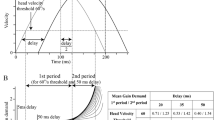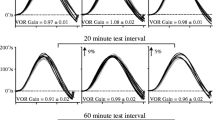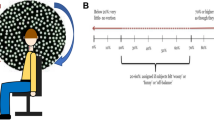Abstract
The vestibulo-ocular reflex (VOR), which stabilizes the eyes in space during head movements, can undergo adaptive modification to maintain retinal stability in response to natural or experimental challenges. A number of models and neural sites have been proposed to account for this adaptation but these do not fully explain how the nervous system can detect and correct errors in both gain and phase of the VOR. This paper presents a general error correction algorithm based on the multiplicative combination of three signals (retinal slip velocity, head position, head velocity) directly relevant to processing of the VOR. The algorithm is highly specific, requiring the combination of particular sets of signals to achieve compensation. It is robust, with essentially perfect compensation observed for all gain (0.25X–4.0X) and phase (-180°–+180°) errors tested. Output of the model closely resembles behavioral data from both gain and phase adaptation experiments in a variety of species. Imposing physiological constraints (no negative activation levels or changes in the sign of unit weights) does not alter the effectiveness of the algorithm. These results suggest that the mechanisms implemented in our model correspond to those implemented in the brain of the behaving organism. Predictions concerning the nature of the adaptive process are specific enough to permit experimental verification using electrophysiological techniques. In addition, the model provides a strategy for adaptive control of any first order mechanical system.
Similar content being viewed by others
References
Arnold DB, Robinson DA (1990) A neural network that learns to integrate oculomotor signals. Proc IJCNN San Diego: II693–II698
Brown TH, Kairiss EW, Keenan CL (1990) Hebbian synapses: biophysical mechanisms and algorithms. Annu Rev Neurosci 13:475–511
Collewijn H, Grootendorst AF (1979) Adaptation of optokinetic and vestibulo-ocular reflexes to modified visual input in the rabbit. Prog Brain Res 50:771–781
Fernandez C, Goldberg JM (1971) Physiology of peripheral neurons innervating semicircular canals of the squirrel monkey. II. Response to sinusoidal stimulation and dynamics of peripheral vestibular system. J Neurophysiol 31:661–675
Galiana, HL (1986) A new approach to understanding adaptive visual-vestibular interactions in the central nervous system. J Neurophysiol 55:349–374
Gauthier GM, Robinson DA (1975) Adaptation of the human vestibuloocular reflex to magnifying lenses. Brain Res 92:331–335
Gonshor A, Melvill Jones G (1976a) Short-term adaptive changes in the human vestibulo-ocular reflex arc. J Physiol (London) 256:361–379
Gonshor A, Melvill Jones G (1976b) Extreme vestibulo-ocular adaptation induced by prolonged optical reversal of vision. J Physiol (London) 256:381–414
Grossberg S (1969) On learning and energy-entropy dependence in recurrent and non-recurrent signal networks. J Stat Phys 1:319–350
Grossberg S (1973) Contour enhancement, short term memory and constancies in reverberating neural networks. Stud Appl Math 12:213–257
Grossberg S, Kuperstein M (1989) Neural dynamics of adaptive sensory-motor control. Pergamon Press, New York
Harrison REW, Baker JF, Isu N, Wickland CR, Peterson BW (1986) Dynamics of adaptive change in vestibulo-ocular reflex direction. I. Rotations in the horizontal plane. Brain Res 371:162–165
Ito M (1982) Cerebellar control of the vestibulo-ocular reflex around the flocculus hypothesis. Annu Rev Neurosci 5:275–296
Keller EL (1973) Accomodative vergence in the alert monkey. Motor unit analysis. Vision Res 13:1565–1575
Khater TT, Baker JF, Peterson BW (1990) Dynamics of adaptive change in human vestibulo-ocular reflex direction. J Vest Res 1:23–29
Lisberger SG (1988) The neural basis for the learning of simple motor skills. Science 242:771–773
Lisberger SG, Miles FA Optican LM (1983) Frequency-selective adaptation: evidence for channels in the vestibulo-ocular reflex? J Neurosci 3:1234–1244
Melvill Jones G (1985) Adaptive modulation of VOR parameters by vision. In: Berthoz A, Melvill Jones G (eds) Adaptive mechanisms in gaze control. Facts and theories. Elsevier, New York, pp 21–50
Melvill Jones G, Davies P (1976) Adaptation of cat vestibulo-ocular reflex to 200 days of optically reversed vision. Brain Res 103:551–554
Miles FA, Eighmy BB (1980) Long-term adaptive changes in primate vestibuloocular reflex. I. Behavioral observations. J Neurophysiol 43:1406–1425
Miles FA, Lisberger SG (1981) Plasticity in the vestibulo-ocular reflex: a new hypothesis. Annu Rev Neurosci 4:273–299
Miles FA, Optican LM, Lisberger SG (1985) An adaptive equalizer model of the primate vestibulo-ocular reflex. In: Berthoz A, Melvill Jones G (eds) Adaptive mechanisms in gaze control. Elsevier, New York
Minsky M, Papert S (1969) Perceptrons. MIT, Cambridge
Paulin MG, Nelson ME, Bower JM (1989) Dynamics of compensatory eye movement control: an optimal estimation analysis of the vestibulo-ocular reflex. Int J Neural Syst 1:23–29
Peterson BW, Baker JF, Houk JC (1991) A model of adaptive control of vestibuloocular reflex based on properties of cross-axis adaptation. Ann NY Acad Sci 627:319–337
Powell KD, Rude SA, Quinn KJ, Peterson BW, Baker JF (1989) Vestibulo-ocular reflex (VOR) direction adaptation to a phase shifted optokinetic stimulus. Soc Neurosci (abstr) 13:1093
Quinn KJ, Schmajuk N, Baker JF, Peterson BW (1990) Modeling the three neuron vestibulo-ocular reflex arc: contribution to eye movement computation. Proc IJCNN San Diego: II699–II704
Raphan T, Cohen B (1985) Velocity storage and the ocular response to multidimensional vestibular stimuli. Elsevier, New York
Robinson DA (1976) Adaptive gain control of vestibuloocular reflex by the cerebellum. J Neurophysiol 39:954–969
Robinson DA (1981) Control of eye movements. In: Brookhart JH, Mountcastle VB (eds) Handbook of physiology. American Physiological Society, Bethesda, pp 1275–1320
Simpson JI (1984) The accessory optic system. Annu Rev Neurosci 7:13–41
Skavenski AA, Robinson DA (1973) Role of abducens neurons in vestibuloocular reflex. J Neurophysiol 36:724–738
Soodak RE, Simpson JI (1988) The accessory optic system of rabbit. Basic visual response properties. J Neurophysiol 60:2037–2054
Stanton PK, Sejnowski TJ (1989) Associative long-term depression in the hippocampus induced by hebbian covariance. Nature 339:215–218
Wilson VJ, Melvill Jones G (1979) Mammalian vestibular physiology. Plenum Press, New York
Author information
Authors and Affiliations
Rights and permissions
About this article
Cite this article
Quinn, K.J., Schmajuk, N., Baker, J.F. et al. Simulation of adaptive mechanisms in the vestibulo-ocular reflex. Biol. Cybern. 67, 103–112 (1992). https://doi.org/10.1007/BF00201017
Received:
Accepted:
Issue Date:
DOI: https://doi.org/10.1007/BF00201017




